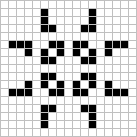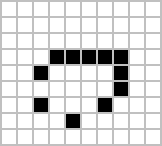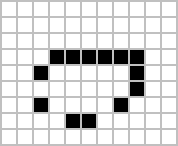Conway's Game of Life is a classic computer science program from the 1970's that simulates a cellular automaton. This program is a zero-player game, meaning that its evolution is determined by its initial state and does not require any further input from the user after the initial input.
To play the game of life all the user needs to do is to create an initial pattern and observe how it evolves.
Over the course of 2 week, we will work on creating our own application in which users will be able to run different "Game of Life" scenarios.
The universe of the Game of Life is an infinite, two-dimensional orthogonal grid of square cells, each of which is in one of two possible states, live or dead.
| Every cell interacts with its eight neighbors, which are the cells that are horizontally, vertically, or diagonally adjacent. |  |
At each step in time, the following transitions occur:
- 1. Any live cell with fewer than two live neighbours dies, as if by underpopulation.
- 2. Any live cell with two or three live neighbours lives on to the next generation.
- 3. Any live cell with more than three live neighbours dies, as if by overpopulation.
- 4. Any dead cell with exactly three live neighbours becomes a live cell, as if by reproduction.
Many different types of patterns occur in the Game of Life, which are classified according to their behaviour.
Still Lifes
Do not change from one generation to the next.
Oscillators
Return to their initial state after a finite number of generations.
Spaceships
Translate themselves across the grid.
My Project Repo — Conway's Game of Life
Project Brief Repo — Lambda School CS Build Week 1
Project Unit 1 Build — Lambda CS Unit 1 Build
Conway's Game of Life General Info — Wikipedia
Video Tutorial In React — Ben Awad














